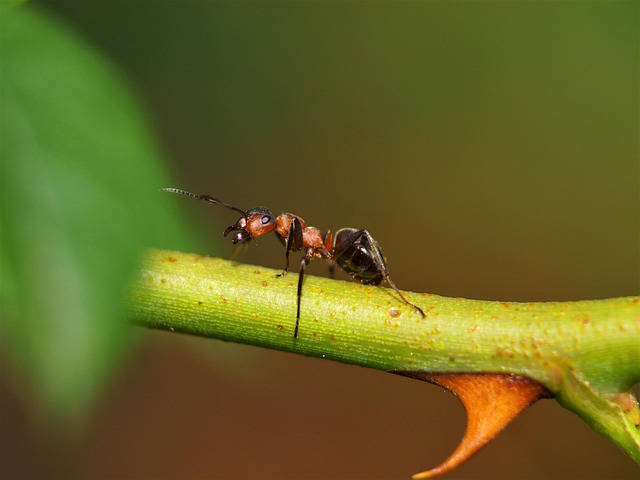Ant infestation removal requires understanding species-specific behaviors and tailoring strategies accordingly. Homeowners can prevent indoor/outdoor infestations through cleanliness, sealing entry points, and natural repellents. Commercial spaces need professional pest control services for effective management, employing baits, regulators, or targeted pesticides. Proactive measures like regular inspections and maintaining clean environments deter ants long-term. Specialized treatments disrupting pheromone trails ensure ant-free spaces for years.
Ant infestations can disrupt residential and commercial spaces, causing distress and damaging property. Understanding ant behaviors and types is the first step towards effective control. This article provides tailored strategies for both homeowners and businesses to address ant infestations, focusing on long-term prevention. Learn about eco-friendly methods, professional interventions, and proactive measures to ensure a pest-free environment through comprehensive ant infestation removal techniques.
Understanding Ant Infestations: Types and Behaviors
Ant infestations can vary greatly depending on the species, with each exhibiting unique behaviors that impact their spread and the effectiveness of removal strategies. Some ants are solitary foragers, seeking out food sources individually, while others form massive colonies with intricate social structures. Understanding these variations is crucial in devising tailored ant control methods. For instance, addressing a colony requires a different approach than managing a group of nomadic ants.
Different ant species also have distinct preferences for habitats and food sources. Common indoor intruders like Argentine ants and odorous ants are drawn to food debris and moisture, while outdoor invaders such as fire ants primarily target green spaces and areas with soil disturbances. Knowing the type of ant infestation is essential for selecting the right tools and techniques for ant infestation removal, ensuring long-term prevention and a pest-free environment in both residential and commercial settings.
Residential Ant Control: Strategies for Homeowners
Residential Ant Control: Strategies for Homeowners
Ant infestations can quickly take over a home, causing distress and damaging structures. For homeowners facing an ant infestation removal challenge, understanding tailored strategies is key to effective control. The first step involves identifying the specific ant species, as different types require distinct approaches. Common ants like the odonta (odonts) or carpenter ants necessitate professional intervention due to their potential for structural damage.
Homeowners can implement preventive measures such as sealing entry points, maintaining cleanliness, and managing food sources to deter ants. Regular inspections and prompt cleanup of spills or crumbs prevent ant trails and subsequent infestations. Additionally, using natural repellents like lemon juice or essential oils along baseboards and doorways can act as a first line of defense.
Commercial Ant Management: Solutions for Businesses
Commercial spaces, from offices to retail stores, often face unique challenges when it comes to ant management due to their size and high-traffic nature. An ant infestation in a commercial setting can disrupt operations, damage goods, and pose health risks to employees and customers alike. Professional pest control services are crucial for effective ant control in these environments.
Business owners should consider proactive measures such as regular inspections, sealing entry points, and maintaining cleanliness to prevent ant infestations. Upon detection, specialized treatments like baits, insect growth regulators, or targeted applications of pesticides can be employed by certified professionals to eliminate ants while minimizing environmental impact. Quick action is vital to contain the issue, ensuring a safe and pest-free working environment for everyone.
Preventive Measures: Long-term Protection Against Ants
Ants are relentless invaders, but with proactive measures, it’s possible to achieve long-term protection against them. Preventive measures for ant infestation removal focus on eliminating entry points and sources of food, which significantly reduces the likelihood of an invasion. This includes sealing gaps around doors and windows, ensuring proper ventilation, and maintaining a clean environment free from spills or crumbs that might attract ants. Regular inspections are also crucial to identify any signs of ant activity early on, allowing for swift action to prevent a full-blown infestation.
For residential and commercial spaces alike, creating an ant-unfriendly environment involves using natural repellents like lemon juice or cinnamon around entry points and keeping outdoor areas well-maintained. Regular pest control services that specialize in ant prevention can also be employed to apply treatments that disrupt ant pheromonal trails and deter their return. These strategies not only protect against current infestations but also serve as robust defenses, ensuring a quieter, ant-free living or working space for years to come.
In addressing ant infestation removal, both residential and commercial spaces require tailored strategies that consider unique behaviors and habitats. From understanding specific types of ants to implementing effective preventive measures, a multi-faceted approach offers long-term protection. For homeowners, targeted actions can mitigate risks, while businesses should adopt robust commercial ant management techniques. By combining strategic interventions with ongoing vigilance, it’s possible to achieve and maintain a pest-free environment.
